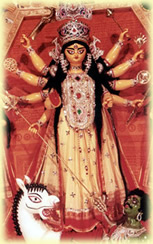|
|
Durga
Puja, also known as Navaratra (nine nights), is a festival observed in
honor of Goddess Durga. This festival continues for nine nights and is
celebrated during the first nine days of bright fortnight of the month
of Asvina (September-October). The tenth day of this festival coincides
with another festivals known as Dussehra, or Vijaydashmi.
 |
In Hindu mythology the Goddess
Durga is one of the principal forms of the divine spouse of Shiva.
Durga Puja is a festival that celebrates her victory over the buffalo
demon Mahisasura. According to the mythological story, Mahisasura
was so powerful that none of the gods were able to destroy him.
The gods, therefore, approached Goddess Durga for help. Each god
gave her best weapons. Equipped with most powerful weapons, Durga
destroyed the powerful demon that the gods had been unable to overcome.
The main ritual of this festival consists of
placing images of the Goddess in homes and temples through the entire
nine nights of the ceremony. |
During the entire ceremony the Goddess is worshipped
with offering of flowers, fruits, and bhajans sung in praise of the deity.
In India the celebration of Navaratri varies significantly from the region
of the country to another. In Tamil Nadu for example, the Goddess Durga
is worshipped daily, but on the ninth day the Goddess is worshipped in
the form of Saraswati, the Goddess of knowledge and learning. In some
regions kanyas (young girls) are worshipped as embodiments of Goddess
and the worship is called Kanya Puja (the worship of young girls). For
this worship nine girls are worshipped on the fifth day of the celebration,
known as Lalita Panchami.
In Bengal huge images (icons) of the Goddess are beautifully decorated
and worshipped during all nine days. The colorful dances and the devotional
singing reach their climax. On the night between the eighth and ninth
days. On the final day, large colorful processions, marked by singing
and dancing carry the images of the Goddess to the sea, river, or lake
for immersion into the water. Thus immersing clay models of Durga in water
indicates that in ultimate analysis the personal and impersonal aspects
of Brahman are one's own spiritual experience.
© 2001 vandemataram.com All rights reserved
|